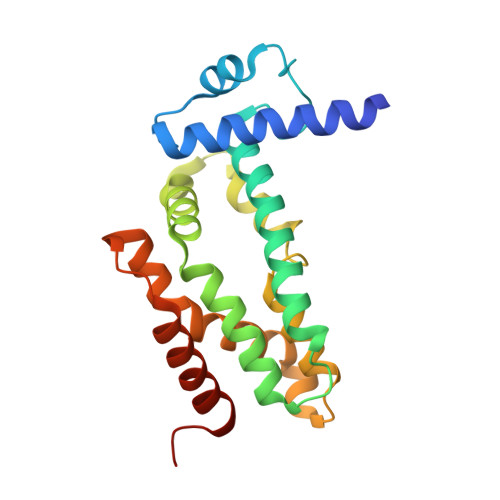Crystal structure of the transcriptional regulator CmeR from Campylobacter jejuni.
Gu, R., Su, C.C., Shi, F., Li, M., McDermott, G., Zhang, Q., Yu, E.W.(2007) J Mol Biol 372: 583-593
- PubMed: 17686491
- DOI: https://doi.org/10.1016/j.jmb.2007.06.072
- Primary Citation of Related Structures:
2QCO - PubMed Abstract:
The CmeABC multidrug efflux pump, which belongs to the resistance-nodulation-division (RND) family, recognizes and extrudes a broad range of antimicrobial agents and is essential for Campylobacter jejuni colonization of the animal intestinal tract by mediating the efflux of bile acids. The expression of CmeABC is controlled by the transcriptional regulator CmeR, whose open reading frame is located immediately upstream of the cmeABC operon. To understand the structural basis of CmeR regulation, we have determined the crystal structure of CmeR to 2.2 A resolution, revealing a dimeric two-domain molecule with an entirely helical architecture similar to members of the TetR family of transcriptional regulators. Unlike the rest of the TetR regulators, CmeR has a large center-to-center distance (54 A) between two N termini of the dimer, and a large flexible ligand-binding pocket in the C-terminal domain. Each monomer forms a 20 A long tunnel-like cavity in the ligand-binding domain of CmeR and is occupied by a fortuitous ligand that is identified as glycerol. The binding of glycerol to CmeR induces a conformational state that is incompatible with target DNA. As glycerol has a chemical structure similar to that of potential ligands of CmeR, the structure obtained mimics the induced form of CmeR. These findings reveal novel structural features of a TetR family regulator, and provide new insight into the mechanisms of ligand binding and CmeR regulation.
Organizational Affiliation:
Department of Physics and Astronomy, Iowa State University, Ames, IA 50011, USA.















